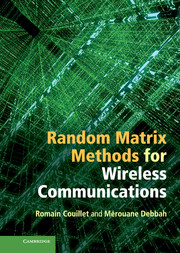Book contents
- Frontmatter
- Contents
- Preface
- Acknowledgments
- Acronyms
- Notation
- 1 Introduction
- Part I Theoretical aspects
- Part II Applications to wireless communications
- 11 Introduction to applications in telecommunications
- 12 System performance of CDMA technologies
- 13 Performance of multiple antenna systems
- 14 Rate performance in multiple access and broadcast channels
- 15 Performance of multi-cellular and relay networks
- 16 Detection
- 17 Estimation
- 18 System modeling
- 19 Perspectives
- 20 Conclusion
- References
- Index
15 - Performance of multi-cellular and relay networks
from Part II - Applications to wireless communications
Published online by Cambridge University Press: 07 October 2011
- Frontmatter
- Contents
- Preface
- Acknowledgments
- Acronyms
- Notation
- 1 Introduction
- Part I Theoretical aspects
- Part II Applications to wireless communications
- 11 Introduction to applications in telecommunications
- 12 System performance of CDMA technologies
- 13 Performance of multiple antenna systems
- 14 Rate performance in multiple access and broadcast channels
- 15 Performance of multi-cellular and relay networks
- 16 Detection
- 17 Estimation
- 18 System modeling
- 19 Perspectives
- 20 Conclusion
- References
- Index
Summary
In this chapter, we move from single-cell considerations, with a central entity, e.g. access point or base station, to the wider multi-user multi-cell network point of view or the multi-hop relay point of view. For the former, we now consider that communications are performed in a cellular environment over a given shared communication resource (e.g. same frequency band, overlaying cell coverage), with possible inter-cell interference. This is a more realistic assumption to model practical communication networks than the isolated single-cell case with additive white Gaussian noise. Here, not only AWGN is affecting the different actors in the network but also cross-talk between adjacent base stations or cell-edge users. For the latter, we do not assume any cellular planning but merely consider multi-hop communications between relays which is of reduced use in commercial communication standards but of high interest to, e.g., ad-hoc military applications.
We start with the multi-cell viewpoint.
Performance of multi-cell networks
We consider the model of a multi-cellular network with overlaying coverage regions. In every cell, each user has a dedicated communication resource, supposed to be orthogonal to any other user's resource. For instance, we may assume that orthogonal frequency division multiple access (OFDMA) is used in every cell, so that users are orthogonally separated both in time and frequency. It is well-known that a major drawback of such networks is their being strongly interference limited since users located at cell edges may experience much interference from signals transmitted in adjacent cells.
- Type
- Chapter
- Information
- Random Matrix Methods for Wireless Communications , pp. 369 - 392Publisher: Cambridge University PressPrint publication year: 2011



